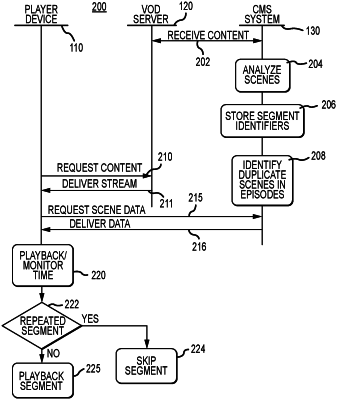| CPC H04N 21/4542 (2013.01) [H04N 21/234345 (2013.01); H04N 21/44008 (2013.01); H04N 21/44204 (2013.01); H04N 21/454 (2013.01)] | 16 Claims |

|
1. An automated process executed by a media player device, the process comprising:
initially rendering, by the media player device, a first media stream comprising a first television program of a program series for playback to a viewer;
receiving, by the media player device from a remotely-located content management system via a network, digital skip data relating to a second television program of the same program series as the first television program, wherein the digital skip data comprises a listing of the duplicate scenes identified in the first and second television programs; and
if a second media stream comprising the second program of the program series is rendered to the viewer within about one hour of the initial rendering of the first media stream, the media player device automatically advancing to a future playback point in the second media stream to skip over the duplicate scenes identified in the listing, and otherwise rendering the second media stream including the duplicate scenes identified in the listing, wherein the duplicate scenes identified in the listing are identified by the content management system performing an automated analysis of the first and second television programs of the series to automatically recognize the at least one duplicate portion of the second television program.
|